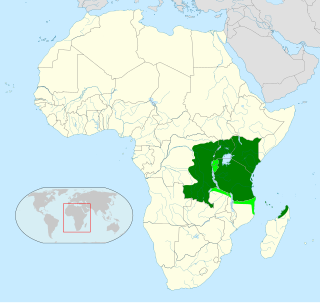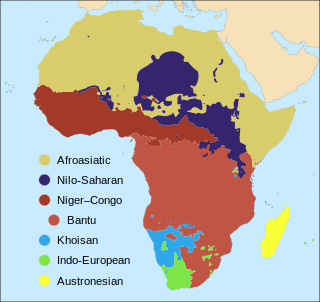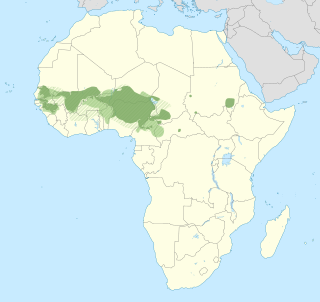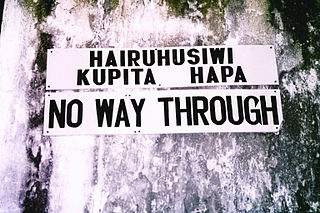Related Research Articles

Swahili, also known by its local name Kiswahili, is a Bantu language spoken by the Swahili people, who are found primarily in Tanzania, Kenya and Mozambique.

Dari, also known as Dari Persian, is the variety of the Persian language spoken in Afghanistan. Dari is the term officially recognised and promoted since 1964 by the Afghan government for the Persian language; it is known as Afghan Persian or Eastern Persian in many Western sources. The decision behind renaming the local variety of Persian was more political than linguistic to support an Afghan state narrative. Apart from a few basics of vocabulary, there is little difference between formal written Persian of Afghanistan and Iran; the languages are mutually intelligible. The term "Dari" is officially used for the characteristic spoken Persian of Afghanistan, but is best restricted to formal spoken registers. Afghanistan's Persian-speaking population still prefer to call their language "Farsi", asserting that the term "Dari" has been imposed upon them by the dominant Pashtun ethnic group as an effort to detach Afghanistan from its deep-rooted cultural, linguistic, and historical connections with the wider Persian-speaking world, encompassing Iran, Tajikistan, and parts of Uzbekistan. Dari is the official language for 35 million Afghans in Afghanistan and it serves as the lingua franca for interethnic communications in Afghanistan.

The number of languages natively spoken in Africa is variously estimated at between 1,250 and 2,100, and by some counts at over 3,000. Nigeria alone has over 500 languages, one of the greatest concentrations of linguistic diversity in the world. The languages of Africa belong to many distinct language families, among which the largest are:

Chikungunya is an infection caused by the Chikungunya virus (CHIKV). The disease was first identified in 1952 in Tanzania and named based on the Kimakonde words for "to become contorted". Symptoms include fever and joint pain. These typically occur two to twelve days after exposure. Other symptoms may include headache, muscle pain, joint swelling, and a rash. Symptoms usually improve within a week; however, occasionally the joint pain may last for months or years. The risk of death is around 1 in 1,000. The very young, old, and those with other health problems are at risk of more severe disease.

Kirundi, also known as Rundi, is a Bantu language and the national language of Burundi. It is a dialect of Rwanda-Rundi dialect continuum that is also spoken in Rwanda and adjacent parts of Tanzania, the Democratic Republic of the Congo, Uganda, as well as in Kenya. Kirundi is mutually intelligible with Kinyarwanda, the national language of Rwanda, and the two form parts of the wider dialect continuum known as Rwanda-Rundi.

Fula, also known as Fulani or Fulah, is a Senegambian language spoken by around 36.8 million people as a set of various dialects in a continuum that stretches across some 18 countries in West and Central Africa. Along with other related languages such as Serer and Wolof, it belongs to the Atlantic geographic group within Niger–Congo, and more specifically to the Senegambian branch. Unlike most Niger-Congo languages, Fula does not have tones.

The Makonde are an ethnic group in southeast Tanzania, northern Mozambique, and Kenya. The Makonde developed their culture on the Mueda Plateau in Mozambique. At present they live throughout Tanzania and Mozambique, and have a small presence in Kenya. The Makonde population in Tanzania was estimated in 2001 to be 1,140,000, and the 1997 census in Mozambique put the Makonde population in that country at 233,358, for an estimated total of 1,373,358. The ethnic group is roughly divided by the Ruvuma River; members of the group in Tanzania are referred to as the Makonde, and those in Mozambique as the Maconde. The two groups have developed separate languages over time but share a common origin and culture.

Makhuwa is the primary Bantu language of northern Mozambique. It is spoken by four million Makua people, who live north of the Zambezi River, particularly in Nampula Province, which is virtually entirely ethnically Makua. It is the most widely spoken indigenous language of Mozambique.
Dinka is a Nilotic dialect cluster spoken by the Dinka people, a major ethnic group of South Sudan. There are several main varieties, such as Padang, Rek, Agaar, Ciec, Apaak, Aliep, Bor, Hol, Twic East and Twic Mayardit, which are distinct enough to require separate literary standards. Jaang, Jieng or Muonyjieng is used as a general term to cover all Dinka languages. Recently Akutmɛ̈t Latueŋ Thuɔŋjäŋ has proposed a unified written grammar of Dinka.

S’gaw, S'gaw Karen, or S’gaw K’Nyaw, commonly known as Karen, is a Sino-Tibetan language spoken by the S'gaw Karen people of Myanmar and Thailand. A Karenic branch of the Sino-Tibetan language family, S'gaw Karen is spoken by over 2 million people in Tanintharyi Region, Ayeyarwady Region, Yangon Region, and Bago Region in Myanmar, and about 200,000 in northern and western Thailand along the border near Kayin State. It is written using the S'gaw Karen alphabet, derived from the Burmese script, although a Latin-based script is also in use among the S'gaw Karen in northwestern Thailand.
The Mwani language, also known by its native name Kimwani, is a Bantu language spoken on the coast of the Cabo Delgado Province of Mozambique, including the Quirimbas Islands. Although it shares high lexical similarity (60%) with Swahili, it is not intelligible with it. It is spoken by around 167,150 people. Speakers also use Portuguese, Swahili and Makhuwa language. Kiwibo, the dialect of the Island of Ibo is the prestige dialect. Kimwani is also called Mwani and Ibo. According to Anthony P. Grant Kimwani of northern Mozambique appears to be the result of imperfect shift towards Swahili several centuries ago by speakers of Makonde, and Arends et al. suggest it might turn out to be a Makonde–Swahili mixed language.
Shilluk is a language spoken by the Shilluk people of South Sudan. It is closely related to other Luo languages. The term Shilluk is a pronunciation of Arabic origin.
Bena is a Bantu language spoken by the Bena people of the Iringa region of Tanzania.
The Zigula or Zigua language, Chizigua, is a Bantu language of Tanzania and Somalia, where the Mushunguli dialect is spoken.
The Lomwe (Lowe) language, Elomwe, also known as Western Makua, is the fourth-largest language in Mozambique. It belongs with Makua in the group of distinctive Bantu languages in the northern part of the country: The Makhuwa-using area proper is separated by a large Lomwe-speaking area from the related eChuwabo, although eMakhuwa neighbours eChuwabo in a more coastal zone. To the south, the rather more distantly related Sena (ChiSena) should be assigned to a group with Nyanja and Chewa, while the distinct group which includes Yao, Makonde and Mwera is found to the north. Apart from the regional variations found within eMakhuwa proper, eLomwe uses ch where tt appears in eMakhuwa orthography: for instance eMakhuwa mirette ("remedy") corresponds to eLomwe mirecce, eMakhuwa murrutthu to eLomwe miruchu, eMakhuwa otthapa ("joy") to eLomwe ochapa.
Mijikenda is a Bantu dialect cluster spoken along the coast of East Africa, mostly in Kenya, where there are 2.6 million speakers but also in Tanzania, where there are 166,000 speakers. The name Mijikenda means "the nine settlements" or "the nine communities" and refers to the multiple language communities that make up the group. An older, derogatory term for the group is Nyika which refers to the "dry and bushy country" along the coast.

Tanzania is a multilingual country. There are many languages spoken in the country, none of which is spoken natively by a majority or a large plurality of the population. Swahili and English, the latter of which was inherited from colonial rule, are widely spoken as lingua francas. They serve as working languages in the country, with Swahili being the official national language. There are more speakers of Swahili than of English in Tanzania.
The Makwe or Macue language is a close relative of Swahili spoken on the coast of the Cabo Delgado Province of Mozambique, and across the border in Mtwara Region of Tanzania. Although it shares high lexical similarity (60%) with Swahili, it is not intelligible with it, nor with its cousin Mwani. Arends et al. suggest it might turn out to be a Makonde–Swahili mixed language.
Ngurimi (Ngoreme) is a Bantu language of Tanzania. Ngoreme is spoken in the Serengeti District of the Mara Region of north-west Tanzania by some 55,000 people. There are two main dialects of Ngoreme - a northern dialect and a southern dialect - which maintain mutual intelligibility.
References
- ↑ Makonde at Ethnologue (26th ed., 2023)

Machinga at Ethnologue (26th ed., 2023)
Ndonde Hamba at Ethnologue (26th ed., 2023)
Matambwe at Ethnologue (26th ed., 2023)
- ↑ Jouni Filip Maho, 2009. New Updated Guthrie List Online
- ↑ Hammarström (2015) Ethnologue 16/17/18th editions: a comprehensive review: online appendices
- ↑ Nurse 2003
- ↑ Morens DM and Fauci AS (2014). "Chikungunya at the Door — Déjà Vu All Over Again?". New England Journal of Medicine. 371 (10): 885–887. doi: 10.1056/NEJMp1408509 . PMID 25029435.
- ↑ Singh, SS; Manimunda, SP; Sugunan, AP; Sahina, Vijayachari P (2008). "Four cases of acute flaccid paralysis associated with chikungunya virus infection". Epidemiol Infect. 136 (9): 1277–80. doi:10.1017/S0950268807009739. PMC 2870928 . PMID 18634716.
- ↑ Kraal, Pieter J. (2005). A Grammar of Makonde (Chinnima, Tanzania). pp. 16–32.